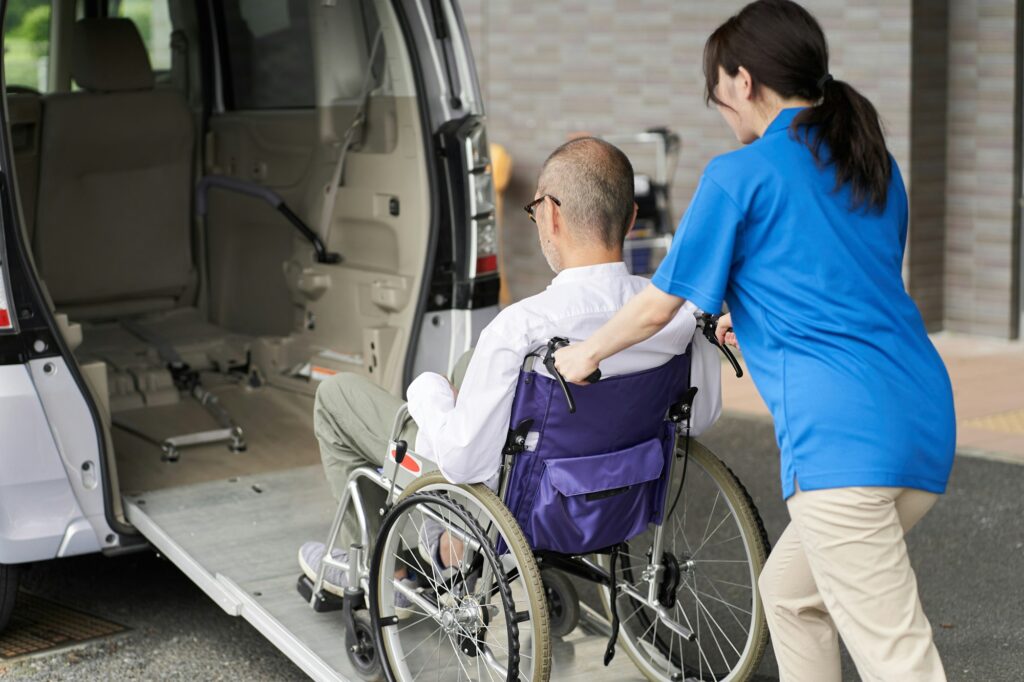Accessible transportation is of utmost importance for seniors with mobility challenges. As individuals age, they may experience a decline in physical abilities, making it difficult for them to travel independently. This can have a significant impact on their quality of life, as they may become isolated and unable to participate in activities and social events. Accessible transportation options provide seniors with the means to maintain their independence and stay connected with their communities.
Understanding the Mobility Challenges Faced by Seniors
Seniors often face a variety of mobility challenges as they age. These challenges can include physical limitations such as reduced strength, balance, and flexibility. Chronic conditions such as arthritis, osteoporosis, and Parkinson’s disease can also contribute to mobility issues. Additionally, cognitive impairments such as dementia or Alzheimer’s disease can affect a senior’s ability to navigate their surroundings safely.
These mobility challenges can greatly impact a senior’s ability to travel. They may struggle with tasks such as getting in and out of vehicles, walking long distances, or navigating public transportation systems. This can lead to feelings of frustration, dependence on others for transportation, and ultimately, a decrease in their overall quality of life.
Importance of Accessible Transportation for Seniors with Mobility Challenges
Accessible transportation plays a crucial role in improving the lives of seniors with mobility challenges. It provides them with the means to travel independently and participate in activities that are important to them. Some of the benefits of accessible transportation for seniors include:
1. Increased Independence: Accessible transportation allows seniors to maintain their independence and freedom to go where they want, when they want. They no longer have to rely on others for transportation, which can be empowering and boost their self-esteem.
2. Social Engagement: Accessible transportation enables seniors to stay connected with their communities and engage in social activities. They can attend events, visit friends and family, and participate in hobbies or volunteer work.
3. Improved Mental and Emotional Well-being: Being able to travel independently can have a positive impact on a senior’s mental and emotional well-being. It can help combat feelings of isolation and loneliness, as they are able to maintain social connections and engage in meaningful activities.
4. Access to Essential Services: Accessible transportation ensures that seniors have access to essential services such as medical appointments, grocery shopping, and banking. This is particularly important for those who may not have access to a personal vehicle or have difficulty using public transportation.
Types of Accessible Transportation for Seniors with Mobility Challenges
| Transportation Type | Accessibility Features | Availability | Cost |
|---|---|---|---|
| Accessible Taxis | Ramps, lowered floors, and wheelchair tie-downs | Varies by city and demand | Typically more expensive than regular taxis |
| Accessible Public Transit | Ramps, low floors, and priority seating | Available in most major cities | Varies by city and type of transit |
| Accessible Ride-Sharing Services | Option to request wheelchair-accessible vehicles | Available in select cities | Varies by service and demand |
| Accessible Van Services | Ramps, lifts, and wheelchair tie-downs | Available in some cities and through private companies | Varies by company and distance |
There are various types of accessible transportation options available for seniors with mobility challenges. These options cater to different needs and preferences, ensuring that seniors can choose the mode of transportation that best suits their individual requirements. Some examples of accessible transportation options include:
1. Wheelchair-Accessible Vehicles: These vehicles are specially designed to accommodate individuals who use wheelchairs or mobility scooters. They feature ramps or lifts for easy entry and exit, as well as securement systems to keep the wheelchair or scooter in place during transit.
2. Accessible Taxis: Accessible taxis are equipped with ramps or lifts to accommodate individuals with mobility challenges. They provide a convenient and flexible option for seniors who require door-to-door transportation.
3. Public Transportation: Many public transportation systems offer accessible options for seniors with mobility challenges. This can include buses or trains with ramps or lifts, priority seating, and audio or visual announcements.
4. Paratransit Services: Paratransit services are specialized transportation services for individuals with disabilities or mobility challenges. These services typically require advance booking and provide door-to-door transportation for eligible individuals.
Public Transportation Options for Seniors with Mobility Challenges
Public transportation can be a cost-effective and convenient option for seniors with mobility challenges. Many cities offer accessible public transportation options that cater to the needs of individuals with disabilities or mobility limitations. Some common accessible public transportation options include:
1. Accessible Buses: Many cities have buses that are equipped with ramps or lifts to accommodate individuals with mobility challenges. These buses also have designated priority seating for seniors and individuals with disabilities.
2. Accessible Trains: Some cities have accessible trains that are designed to accommodate individuals with mobility challenges. These trains may have ramps or lifts for easy boarding, as well as designated priority seating.
3. Accessible Light Rail Systems: Light rail systems are becoming increasingly popular in urban areas. These systems often have accessible features such as ramps or lifts, priority seating, and audio or visual announcements.
While public transportation can be a convenient option for seniors with mobility challenges, there are also some drawbacks to consider. Public transportation schedules may not always align with a senior’s needs, and there may be limitations on the number of stops or destinations available. Additionally, navigating public transportation systems can be challenging for individuals with cognitive impairments.
Private Transportation Options for Seniors with Mobility Challenges

Private transportation options provide seniors with more flexibility and convenience compared to public transportation. These options cater specifically to the needs of individuals with mobility challenges and offer a more personalized experience. Some private transportation options for seniors include:
1. Accessible Taxis: Accessible taxis are a popular choice for seniors who require door-to-door transportation. These taxis are equipped with ramps or lifts to accommodate individuals with mobility challenges.
2. Ride-Sharing Services: Ride-sharing services such as Uber and Lyft have become increasingly popular in recent years. Many of these services offer accessible vehicles that can accommodate individuals with mobility challenges.
3. Non-Emergency Medical Transportation: Non-emergency medical transportation services provide transportation for individuals who require medical appointments or treatments. These services often have accessible vehicles and trained drivers who can assist seniors with mobility challenges.
Private transportation options offer several advantages for seniors with mobility challenges. They provide a more personalized and flexible experience, allowing seniors to travel on their own schedule and to destinations of their choice. However, private transportation options can be more expensive compared to public transportation, and availability may vary depending on the location.
Choosing the Right Accessible Transportation for Seniors with Mobility Challenges
When choosing accessible transportation for seniors with mobility challenges, there are several factors to consider. These factors can help determine which option is best suited to an individual’s needs and preferences. Some factors to consider include:
1. Mobility Needs: Consider the specific mobility challenges of the senior and choose a transportation option that can accommodate those needs. For example, if the senior uses a wheelchair or mobility scooter, a wheelchair-accessible vehicle or accessible taxi may be the best choice.
2. Destination and Distance: Consider the destinations the senior needs to travel to and the distance involved. Some transportation options may be more suitable for short trips within a local area, while others may be better for longer journeys.
3. Cost: Consider the cost of different transportation options and how it fits within the senior’s budget. Public transportation options are generally more affordable, while private transportation options may be more expensive.
4. Availability: Consider the availability of different transportation options in the senior’s area. Some options may be more readily available in urban areas compared to rural areas.
It is important to involve the senior in the decision-making process and take their preferences into account. They should feel comfortable and confident with the chosen transportation option.
Tips for Planning a Safe and Comfortable Journey for Seniors with Mobility Challenges
Planning a trip for a senior with mobility challenges requires careful consideration to ensure their safety and comfort throughout the journey. Here are some tips for planning a safe and comfortable journey:
1. Plan Ahead: Plan the trip in advance, taking into account any specific needs or requirements of the senior. This includes considering accessibility features at the destination, such as ramps or elevators.
2. Allow Extra Time: Allow extra time for the journey to account for any potential delays or unforeseen circumstances. This can help reduce stress and ensure a more relaxed travel experience.
3. Pack Essentials: Pack any necessary items such as medications, mobility aids, and personal care items. It is also a good idea to carry a list of emergency contacts and important medical information.
4. Communicate with Transportation Providers: If using public transportation or private transportation services, communicate with the providers in advance to ensure they are aware of any specific needs or requirements. This can help them make necessary accommodations and provide a smoother travel experience.
5. Stay Hydrated and Comfortable: Encourage the senior to stay hydrated throughout the journey and dress comfortably. This can help prevent discomfort and fatigue during travel.
Overcoming Barriers to Accessible Transportation for Seniors with Mobility Challenges
While accessible transportation options are available, there are still barriers that can prevent seniors with mobility challenges from accessing these services. Some common barriers include:
1. Lack of Awareness: Many seniors may not be aware of the accessible transportation options available to them. It is important to educate seniors and their caregivers about the different options and how to access them.
2. Limited Availability: Accessible transportation options may be limited in certain areas, particularly in rural or remote locations. This can make it difficult for seniors in these areas to access transportation services.
3. Affordability: Private transportation options can be more expensive compared to public transportation, making them less accessible for seniors on a limited budget.
4. Physical Barriers: Some seniors may face physical barriers that prevent them from accessing transportation services, such as inaccessible bus stops or lack of ramps or elevators at train stations.
To overcome these barriers, it is important for communities and transportation providers to work together to improve accessibility and increase awareness of available services. This can include implementing infrastructure improvements, providing training for drivers and staff, and promoting accessible transportation options to seniors and their caregivers.
Empowering Seniors with Mobility Challenges through Accessible Transportation
Accessible transportation plays a vital role in empowering seniors with mobility challenges to live independently and participate in their communities. It provides them with the means to maintain their independence, stay connected with their communities, and engage in activities that are important to them. By understanding the mobility challenges faced by seniors, recognizing the importance of accessible transportation, and exploring the different options available, we can ensure that seniors with mobility challenges have the support they need to live fulfilling and active lives.
If you’re looking for transportation options for seniors with mobility issues, you may find this article on “What to Know When Transporting Senior Citizens” helpful. It provides valuable information on how to ensure a safe and comfortable transportation experience for elderly individuals. From understanding their specific needs to choosing the right mode of transportation, this article covers it all. Check it out here for expert advice and guidance.
